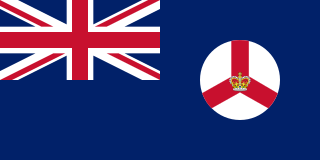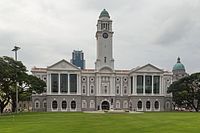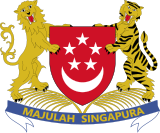
The Straits Settlements were a group of British territories located in Southeast Asia. Originally established in 1826 as part of the territories controlled by the British East India Company, the Straits Settlements came under control of the British Raj in 1858 and then under direct British control as a Crown colony in 1867. In 1946, following the end of World War II and the Japanese occupation, the colony was dissolved as part of Britain's reorganisation of its Southeast Asian dependencies in the area.

The Malayan Union was a union of the Malay states and the Straits Settlements of Penang and Malacca. It was the successor to British Malaya and was conceived to unify the Malay Peninsula under a single government to simplify administration. Following opposition by the ethnic Malays, the union was reorganised as the Federation of Malaya in 1948.

The Federation of Malaya, more commonly known as Malaya, was a country of what previously had been the Malayan Union and, before that, British Malaya. It comprised eleven states – nine Malay states and two of the Straits Settlements, Penang and Malacca. It was established on 1 February 1948.

The legal system of Singapore is based on the English common law system. Major areas of law – particularly administrative law, contract law, equity and trust law, property law and tort law – are largely judge-made, though certain aspects have now been modified to some extent by statutes. However, other areas of law, such as criminal law, company law and family law, are largely statutory in nature.

The Legislative Council of the Straits Settlements was a legislature formed on 1 April 1867, when the Straits Settlements was made a Crown colony. This allowed laws to be made swiftly and efficiently, as it was directly responsible to the Secretary of State for the Colonies in London, instead of being placed under a legislative hierarchy and answering to the Calcutta government based in India.

The term "British Malaya" loosely describes a set of states on the Malay Peninsula and the island of Singapore that were brought under British hegemony or control between the late 18th and the mid-20th century. Unlike the term "British India", which excludes the Indian princely states, British Malaya is often used to refer to the Federated and the Unfederated Malay States, which were British protectorates with their own local rulers, as well as the Straits Settlements, which were under the sovereignty and direct rule of the British Crown, after a period of control by the East India Company.
Sir Percy Alexander McElwaine KC was a lawyer and judge who served, inter alia, as Attorney General of Fiji and Chief Justice of the Straits Settlements.

Singapore in the Straits Settlements refers to a period in the history of Singapore between 1826 and 1942, during which Singapore was part of the Straits Settlements together with Penang and Malacca. Singapore was the capital and the seat of government of the Straits Settlement after it was moved from George Town in 1832.

The Colony of Singapore was a Crown colony of the United Kingdom that encompassed what is modern-day Singapore from 1946 to 1958. During this period, Christmas Island, the Cocos (Keeling) Islands, and Labuan were also administered from Singapore. Singapore had previously been established as a British colony since 1824, and had been governed as part of the Straits Settlements since 1826. The colony was created when the Straits Settlements was dissolved shortly after the Japanese occupation of Singapore ended in 1945. The power of the British Government was vested in the governor of Singapore. The colony eventually gained partial internal self-governance in 1955, and lasted until the establishment of the State of Singapore in 1958, with full internal self-governance granted in 1959.

The Federal Court of Malaysia is the highest court and the final appellate court in Malaysia. It is housed in the Palace of Justice in Putrajaya. The court was established during Malaya's independence in 1957 and received its current name in 1994.

Robert Ibbetson was a colonial governor of the Straits Settlements of Penang, Malacca, and Singapore from 1832 to 1834.
The chief secretary of Singapore, known as the colonial secretary of Singapore before 1955, and the colonial secretary of the Straits Settlements before 1946, was a high ranking government official position in the Straits Settlements before 1946 and the Colony of Singapore after 1946, between 1867 and 1959. It was second only to the governor of Singapore, formerly the governor of the Straits Settlements in the colonial government.
The Queen Victoria Memorial in George Town, Penang is a monument to Queen Victoria, begun after her death, located at the Penang Chinese Recreation Club. Penang's Victoria Memorial takes the form of a large piece of land known as "Victoria Green," and a statue at the edge of Victoria Green at the junction of Burmah Road and Pangkor Road, the establishment of each being years apart from the other. The grounds were purchased and set up in 1903 and the statue unveiled in 1930, nearly three decades later.

Robert Norman Bland (1859–1948), or "R. N. Bland," as he was more commonly known then in The Straits, was Resident Councillor of Penang and a career civil servant in the Colonial Administration of the Straits Settlements.

The Crown Colony of Penang was a British crown colony from 1946 to 1957. It came under British sovereignty after being ceded by the Sultanate of Kedah in 1786, and had been part of the Straits Settlements from 1826 to 1946. Together with Singapore, it became a crown colony under the direct control of the British Colonial Office in London until it was incorporated into the Malayan Union.
Charles Walter Sneyd-Kynnersley, was a British colonial administrator. He joined the Straits Settlements Civil Service in 1872 and was the acting Colonial Secretary of Straits Settlements.

The Penang secessionist movement was a separatist movement whose objective was to achieve the independence of Penang from the Federation of Malaya. Between 1948 and 1957, the movement was driven by commercial elites, predominantly from non-Malay ethnic backgrounds. It stemmed from concerns that Penang's non-Malay majority would be marginalised under the Ketuanan Melayu agenda and that Penang's economic prospects would be undermined by the new Malayan government. Ultimately, the movement was defeated in Penang's legislature and attempts to garner support from the British government were unsuccessful.















